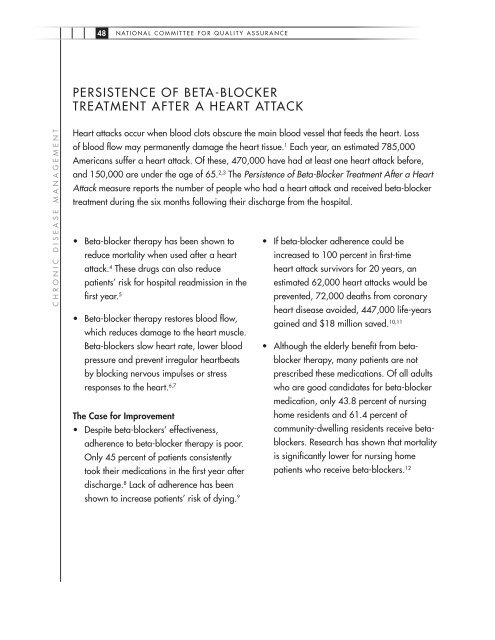Continuous Improvement and the Expansion of Quality ... - NCQA
Continuous Improvement and the Expansion of Quality ... - NCQA
Continuous Improvement and the Expansion of Quality ... - NCQA
You also want an ePaper? Increase the reach of your titles
YUMPU automatically turns print PDFs into web optimized ePapers that Google loves.
C H R o N I C D I S E A S E M A N A G E M E N T<br />
48<br />
N AT I o N A l C o M M I T T E E f o R Q U A l I T y A S S U R A N C E<br />
PERSISTENCE <strong>of</strong> bETA-bloCkER<br />
TREATMENT AfTER A HEART ATTACk<br />
Heart attacks occur when blood clots obscure <strong>the</strong> main blood vessel that feeds <strong>the</strong> heart. loss<br />
<strong>of</strong> blood flow may permanently damage <strong>the</strong> heart tissue. 1 Each year, an estimated 785,000<br />
Americans suffer a heart attack. <strong>of</strong> <strong>the</strong>se, 470,000 have had at least one heart attack before,<br />
<strong>and</strong> 150,000 are under <strong>the</strong> age <strong>of</strong> 65. 2,3 The Persistence <strong>of</strong> Beta-Blocker Treatment After a Heart<br />
Attack measure reports <strong>the</strong> number <strong>of</strong> people who had a heart attack <strong>and</strong> received beta-blocker<br />
treatment during <strong>the</strong> six months following <strong>the</strong>ir discharge from <strong>the</strong> hospital.<br />
• beta-blocker <strong>the</strong>rapy has been shown to<br />
reduce mortality when used after a heart<br />
attack. 4 These drugs can also reduce<br />
patients’ risk for hospital readmission in <strong>the</strong><br />
first year. 5<br />
• beta-blocker <strong>the</strong>rapy restores blood flow,<br />
which reduces damage to <strong>the</strong> heart muscle.<br />
beta-blockers slow heart rate, lower blood<br />
pressure <strong>and</strong> prevent irregular heartbeats<br />
by blocking nervous impulses or stress<br />
responses to <strong>the</strong> heart. 6,7<br />
<strong>the</strong> Case for <strong>Improvement</strong><br />
• Despite beta-blockers’ effectiveness,<br />
adherence to beta-blocker <strong>the</strong>rapy is poor.<br />
only 45 percent <strong>of</strong> patients consistently<br />
took <strong>the</strong>ir medications in <strong>the</strong> first year after<br />
discharge. 8 lack <strong>of</strong> adherence has been<br />
shown to increase patients’ risk <strong>of</strong> dying. 9<br />
• If beta-blocker adherence could be<br />
increased to 100 percent in first-time<br />
heart attack survivors for 20 years, an<br />
estimated 62,000 heart attacks would be<br />
prevented, 72,000 deaths from coronary<br />
heart disease avoided, 447,000 life-years<br />
gained <strong>and</strong> $18 million saved. 10,11<br />
• Although <strong>the</strong> elderly benefit from betablocker<br />
<strong>the</strong>rapy, many patients are not<br />
prescribed <strong>the</strong>se medications. <strong>of</strong> all adults<br />
who are good c<strong>and</strong>idates for beta-blocker<br />
medication, only 43.8 percent <strong>of</strong> nursing<br />
home residents <strong>and</strong> 61.4 percent <strong>of</strong><br />
community-dwelling residents receive betablockers.<br />
Research has shown that mortality<br />
is significantly lower for nursing home<br />
patients who receive beta-blockers. 12


